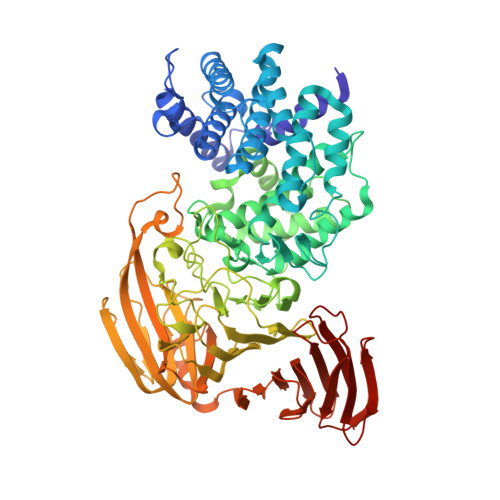Crystal Structure of Bacillus sp. GL1 Xanthan Lyase Complexed with a Substrate: Insights into the Enzyme Reaction Mechanism
Maruyama, Y., Hashimoto, W., Mikami, B., Murata, K.(2005) J Mol Biol 350: 974-986
- PubMed: 15979090
- DOI: https://doi.org/10.1016/j.jmb.2005.05.055
- Primary Citation of Related Structures:
1X1H, 1X1I, 1X1J - PubMed Abstract:
Bacillus sp. GL1 xanthan lyase, a member of polysaccharide lyase family 8 (PL-8), acts exolytically on the side-chains of pentasaccharide-repeating polysaccharide xanthan and cleaves the glycosidic bond between glucuronic acid (GlcUA) and pyruvylated mannose (PyrMan) through a beta-elimination reaction. To clarify the enzyme reaction mechanism, i.e. its substrate recognition and catalytic reaction, we determined crystal structures of a mutant enzyme, N194A, in complexes with the product (PyrMan) and a substrate (pentasacharide) and in a ligand-free form at 1.8, 2.1, and 2.3A resolution. Based on the structures of the mutant in complexes with the product and substrate, we found that xanthan lyase recognized the PyrMan residue at subsite -1 and the GlcUA residue at +1 on the xanthan side-chain and underwent little interaction with the main chain of the polysaccharide. The structure of the mutant-substrate complex also showed that the hydroxyl group of Tyr255 was close to both the C-5 atom of the GlcUA residue and the oxygen atom of the glycosidic bond to be cleaved, suggesting that Tyr255 likely acts as a general base that extracts the proton from C-5 of the GlcUA residue and as a general acid that donates the proton to the glycosidic bond. A structural comparison of catalytic centers of PL-8 lyases indicated that the catalytic reaction mechanism is shared by all members of the family PL-8, while the substrate recognition mechanism differs.
Organizational Affiliation:
Laboratory of Molecular Biotechnology, Division of Food Science and Biotechnology, Graduate School of Agriculture, Kyoto University, Uji, Kyoto 611-0011, Japan.















